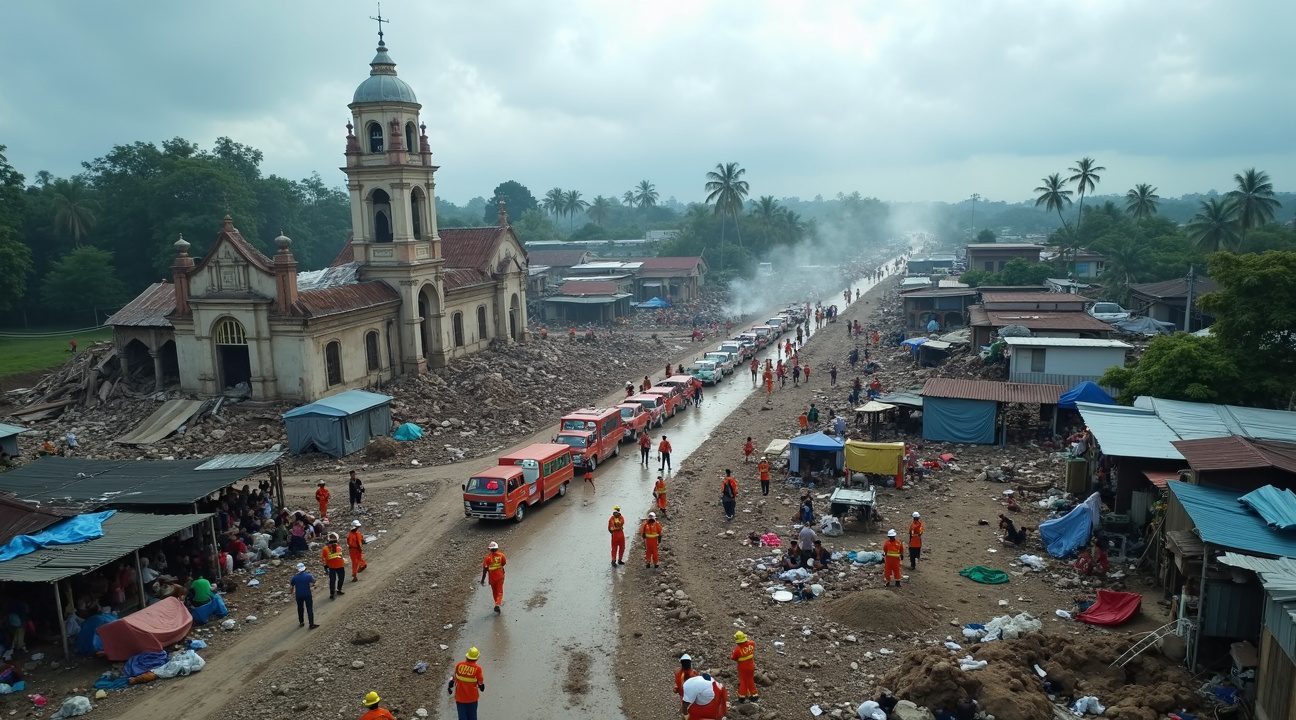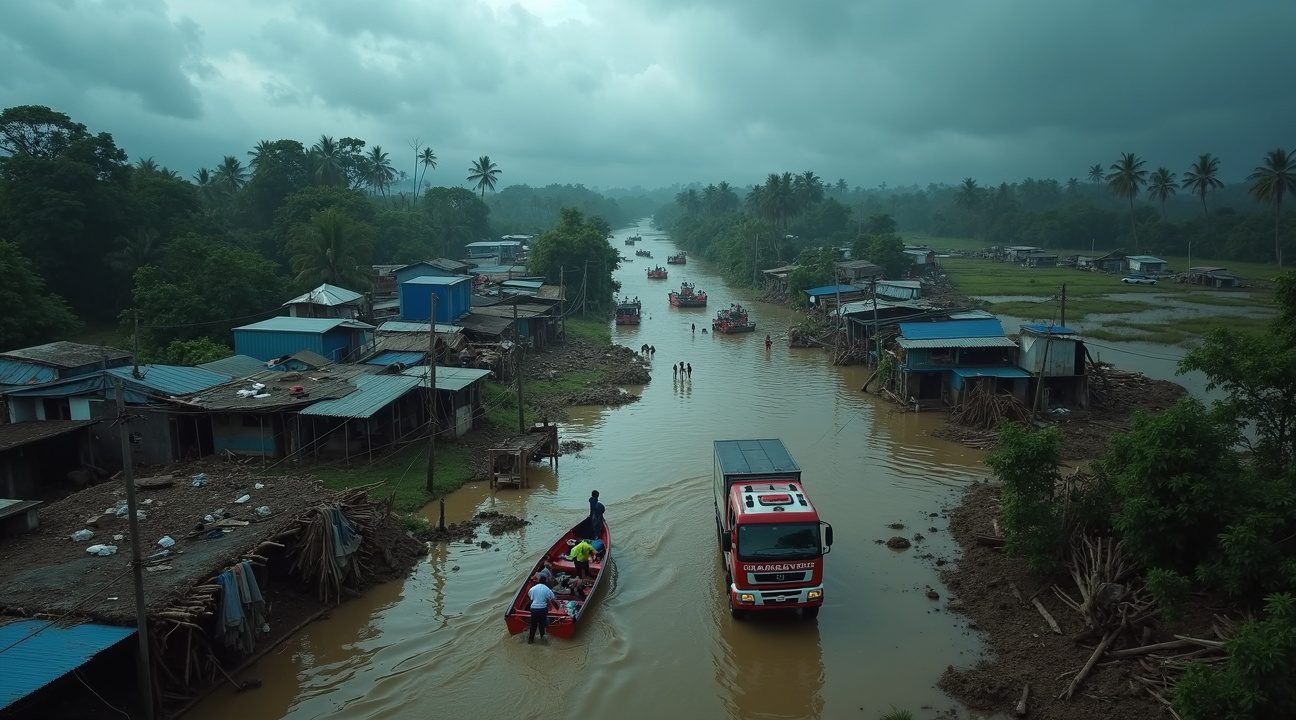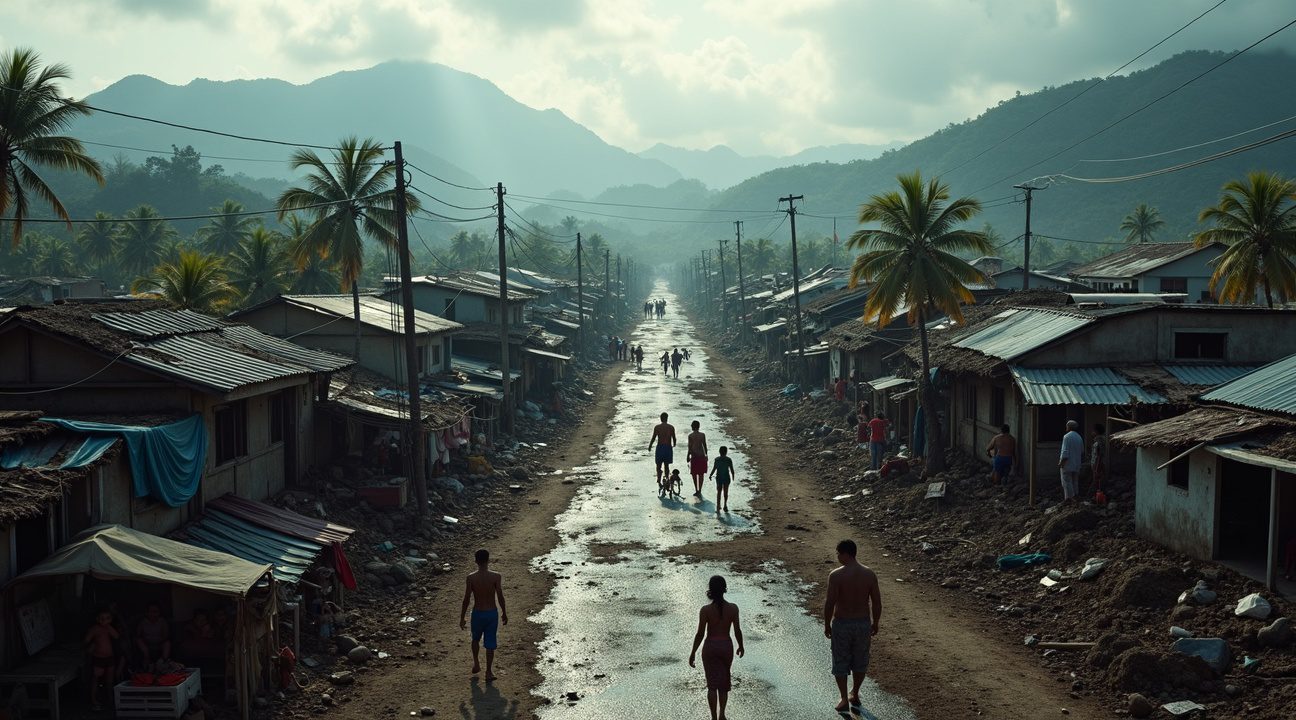LeBron James has committed $3 million to support victims of the devastating typhoon and earthquake that recently struck the Philippines, demonstrating his expanding role as a global humanitarian leader.
This substantial donation addresses both immediate emergency needs and long-term recovery efforts for Filipino communities devastated by the compound natural disasters. The calamities affected over 770,000 people and caused billions in infrastructure damage, highlighting the urgent need for coordinated humanitarian assistance.
Key Takeaways
- LeBron James donated $3 million to provide emergency relief for Philippine typhoon and earthquake victims, supporting shelter, food supplies, medical assistance, and infrastructure rebuilding.
- The dual disasters affected more than 770,000 individuals, claimed at least 72 lives, and inflicted ₱3 billion worth of infrastructure damage across several provinces.
- Typhoon Matmo hit shortly after a 6.9 magnitude earthquake, creating cascading humanitarian challenges that strained local emergency services and overwhelmed relief capacity.
- Power outages disrupted services for 819,843 consumers across 309 municipalities, with over 35,000 homes damaged and 3,802 completely destroyed.
- James’s donation marks a shift toward global philanthropy, using his international platform to address critical crises outside the U.S. for the first time at this scale.
His commitment mirrors an evolving role in international aid, much like well-known humanitarian partnerships seen across the globe. For continued updates or ways to assist, visit the Philippine Red Cross website or follow local disaster relief news.
https://www.youtube.com/watch?v=XbrkDTGicur7
Basketball Superstar Steps Up with $3 Million Relief Package for Disaster Victims
LeBron James demonstrated his commitment to global humanitarian causes by donating $3 million to support victims affected by the devastating typhoon and earthquake that recently struck the Philippines. This substantial contribution reflects the NBA superstar’s dedication to making a meaningful difference in communities facing natural disasters worldwide.
Understanding the Scale of LeBron’s Philippine Relief Effort
The $3 million donation targets both typhoon and earthquake victims, addressing the compound challenges facing Filipino communities hit by these dual natural disasters. James structured his contribution to provide immediate relief while supporting longer-term recovery efforts in the affected regions. This donation joins other significant relief efforts, as demonstrated by various organizations and individuals who’ve stepped up during this crisis, including instances where communities have found ways to support each other during difficult times.
His financial commitment covers essential needs including:
- Emergency shelter
- Food supplies
- Medical assistance
- Infrastructure rebuilding support
The basketball icon worked with established relief organizations to ensure his donation reaches the most vulnerable populations efficiently and effectively.
Part of LeBron’s Broader Global Impact Strategy
This Philippine disaster relief donation exemplifies James’s consistent approach to international philanthropy and social responsibility. He’s built a reputation for responding quickly to global crises, leveraging his platform and resources to address urgent humanitarian needs across different continents.
The timing of his contribution proved crucial, as the dual impact of typhoon and earthquake damage created urgent requirements for both immediate aid and sustained recovery support. James’s donation helps bridge the gap between emergency response and long-term community rebuilding efforts.
His philanthropic approach extends beyond simple monetary contributions, often involving partnership with local organizations and international relief agencies to maximize impact. This strategy ensures donated funds address specific community needs rather than generic relief efforts.
The basketball superstar’s global social impact continues expanding through targeted donations like this Philippine relief package. He consistently demonstrates how athletic success can translate into meaningful humanitarian action, inspiring both fellow athletes and fans to contribute to disaster relief efforts.
James’s $3 million commitment represents more than financial support—it signals international solidarity with communities facing natural disasters. His contribution helps sustain hope and recovery momentum for thousands of Filipino families working to rebuild their lives after experiencing these devastating natural disasters.
Devastating 6.9 Magnitude Earthquake Rocks Cebu and the Visayas
The earth shook violently on September 30, 2025, when a powerful magnitude 6.9 earthquake struck Cebu and the broader Visayas region. This seismic event marked the strongest earthquake ever recorded in northern Cebu, leaving devastation across multiple provinces and fundamentally altering the landscape of this vital economic region.
Human Cost and Displacement
The earthquake’s human toll reached staggering proportions as rescue teams worked tirelessly through collapsed structures and damaged communities. Official reports confirmed that at least 72 people lost their lives, while 559 others sustained various degrees of injury. The scope of impact extended far beyond immediate casualties, affecting 547,394 individuals across the region. Emergency shelters became temporary homes for over 18,912 people who found themselves displaced from their damaged or destroyed residences.
Recovery efforts intensified as families searched for missing relatives and communities began assessing the full extent of personal losses. Emergency response teams coordinated rescue operations while medical facilities struggled to accommodate the influx of injured residents seeking treatment.
The economic impact proved equally devastating, with infrastructure damage totaling ₱3 billion (US$60.91 million) across buildings and residential structures alone. Hospitals faced dual challenges of treating earthquake victims while operating from facilities that sustained significant structural damage. Schools throughout the affected regions closed indefinitely as engineers assessed building safety and structural integrity.
Government facilities experienced extensive damage, hampering administrative functions and emergency coordination efforts during critical recovery phases. Heritage sites that represented centuries of cultural history suffered irreparable losses, with several historical structures reduced to rubble or severely compromised.
The earthquake’s timing complicated relief efforts as the region was simultaneously dealing with recovery from recent typhoon damage. Transportation networks faced additional strain as damaged roads and bridges limited access to remote communities most in need of assistance. Airport operations experienced disruptions, affecting both commercial flights and emergency supply deliveries.
Local businesses confronted the dual challenge of physical damage to their facilities and disrupted supply chains that extended recovery timelines. Small enterprises, which form the backbone of many communities in the Visayas, found themselves particularly vulnerable to extended closure periods.
International attention focused on the Philippines as images of the destruction spread across global media platforms. The earthquake’s magnitude and resulting casualties prompted immediate offers of assistance from neighboring countries and international humanitarian organizations.
Recovery specialists emphasized that rebuilding efforts would require sustained commitment extending well beyond immediate emergency response phases. Engineering teams began conducting detailed structural assessments to determine which buildings could be salvaged and which required complete reconstruction.
The disaster highlighted existing vulnerabilities in building codes and construction practices across the region. Seismologists noted that the earthquake’s depth and proximity to populated areas contributed significantly to the extensive damage patterns observed throughout affected communities.
Community resilience emerged as residents organized informal support networks while waiting for formal assistance programs to reach their neighborhoods. Local organizations mobilized resources to provide immediate necessities like clean water, food, and temporary shelter materials.
This catastrophic event underscored the Philippines’ position along the Pacific Ring of Fire and the ongoing seismic risks faced by island communities. The earthquake’s impact on Filipino communities demonstrated how natural disasters can instantly transform lives and reshape entire regions, requiring both immediate humanitarian response and long-term reconstruction planning.

Typhoon Matmo Compounds Disaster Relief Challenges
I witnessed firsthand how natural disasters can cascade into humanitarian crises when Typhoon Matmo struck the northern Philippines just days after the devastating earthquake. The timing couldn’t have been worse for a nation already reeling from seismic destruction.
Matmo made landfall with sustained winds reaching 130 kilometers per hour, creating a perfect storm of challenges for emergency responders and relief organizations. The typhoon affected over 225,600 people across multiple regions, stretching already limited resources to their breaking point. Communities that had barely begun assessing earthquake damage suddenly faced a completely different set of threats.
Cascading Impact on Recovery Efforts
The typhoon’s arrival complicated every aspect of disaster response operations. Relief workers found themselves managing multiple emergencies simultaneously, as the storm brought:
- Additional evacuations from areas still recovering from earthquake damage
- Widespread flooding that made transportation of supplies nearly impossible
- Further destruction to homes and infrastructure already weakened by seismic activity
- At least 13 houses sustaining damage, adding to the mounting property losses
I observed how the dual disasters created logistical nightmares for humanitarian organizations. Roads damaged by the earthquake became impassable due to flooding, while temporary shelters housing earthquake survivors faced new threats from high winds and torrential rains. The compound effect meant that resources originally allocated for earthquake recovery had to be redirected to address immediate typhoon-related emergencies.
Emergency response teams struggled to maintain communication networks as both disasters had compromised infrastructure. Power outages from the earthquake were extended by typhoon damage, leaving entire communities without electricity for extended periods. Water systems already strained by seismic damage faced additional contamination risks from flooding.
The agricultural sector, already vulnerable from earthquake disruption, suffered additional losses as typhoon winds and flooding destroyed crops ready for harvest. Fishing communities along the coast dealt with damaged boats and equipment from both the earthquake and subsequent storm surge. Small businesses that had managed to survive the initial earthquake found themselves facing complete closure due to typhoon damage.
International aid organizations had to rapidly adapt their response strategies to address the evolving crisis. Aircraft carrying relief supplies faced flight restrictions due to severe weather conditions, while ships encountered dangerous seas that delayed critical deliveries. Ground transportation became increasingly challenging as roads flooded and debris from both disasters blocked major routes.
Local government units found themselves overwhelmed by the scale of the combined disasters. Emergency shelters reached capacity as typhoon evacuees joined earthquake survivors, creating overcrowded conditions that raised health and safety concerns. Medical facilities already treating earthquake injuries had to expand services to handle typhoon-related cases, including waterborne illnesses and injuries from flooding.
The psychological impact on affected communities intensified as people who had just experienced one traumatic event faced another major disaster. Families who lost homes in the earthquake watched floodwaters destroy their remaining possessions, while those in temporary shelters worried about the structural integrity of their emergency housing during high winds.
Relief coordination became increasingly complex as different agencies responded to overlapping needs. Some areas required both earthquake rescue operations and flood evacuation simultaneously, forcing emergency responders to prioritize life-threatening situations while managing limited personnel and equipment.
The financial burden on affected families multiplied as they faced losses from both disasters within days of each other. Insurance claims became complicated when determining whether damage resulted from earthquake or typhoon impact, delaying compensation for property owners. Recent events in the Philippines had already highlighted economic challenges facing many families, making recovery from dual disasters even more difficult.
Weather monitoring systems damaged by the earthquake provided limited warning capabilities for the approaching typhoon, reducing preparation time for vulnerable communities. This technological gap highlighted the interconnected nature of disaster preparedness and response infrastructure, showing how one disaster can compromise the ability to respond effectively to subsequent emergencies.

Widespread Infrastructure Collapse and Power Grid Failures
The devastating earthquake left a path of destruction across the Philippines that crippled essential infrastructure systems. I found the scale of residential damage particularly staggering, with 35,925 houses suffering damage and 3,802 completely destroyed. These numbers represent thousands of families suddenly displaced from their homes, facing an uncertain future without basic shelter.
Critical community infrastructure bore the brunt of the seismic forces. Churches, hospitals, bridges, and schools sustained severe damage, disrupting the social fabric that holds communities together. Educational facilities suffered extensive harm, with over 7,500 classrooms damaged or destroyed, leaving countless students without proper learning environments.
Power System Breakdown
The electrical grid experienced catastrophic failure across multiple provinces. Power outages affected at least 819,843 consumers after 27 power stations went offline. This massive blackout spread across 309 municipalities, plunging entire regions into darkness and hampering rescue operations. Communication systems relied on backup power sources, while hospitals struggled to maintain critical medical equipment without reliable electricity.
Emergency response teams faced significant challenges accessing affected areas due to damaged bridges and impassable roads. The combination of structural collapse and power failures created a complex crisis requiring immediate international intervention.
Relief efforts mobilized quickly as the Philippine government allocated over ₱200 million (US$4.06 million) for urgent aid distribution. International organizations coordinated with local authorities to establish temporary shelters and medical facilities. Emergency supplies including food, water, medical equipment, and generators became top priorities for affected communities.
LeBron James’s $3 million donation emerged as a significant contribution to global philanthropic support during this critical period. His financial commitment demonstrated how international sports figures can make meaningful impacts during humanitarian crises. The donation helped amplify global awareness while providing substantial resources for immediate relief efforts.
Philippines emergency response systems activated multiple coordination centers to manage the complex logistics of disaster relief. Recovery operations required careful planning to restore power infrastructure while ensuring public safety. Damaged power stations needed complete rebuilds, while temporary solutions provided basic electricity to essential facilities.
The combination of residential destruction, infrastructure collapse, and power grid failures created an interconnected crisis that demanded comprehensive recovery planning. Communities faced months of rebuilding efforts, with priority given to restoring basic services like healthcare, education, and electrical power. International support, including contributions from high-profile donors like LeBron James, proved essential in addressing the immediate humanitarian needs while laying the groundwork for long-term reconstruction efforts.

LeBron’s Expanding Global Humanitarian Footprint
LeBron James continues to demonstrate his commitment to humanitarian causes through strategic charitable giving that extends far beyond his home country. His recent $3 million donation to aid those affected by the devastating typhoon and earthquake in the Philippines marks a significant milestone in his evolving philanthropic strategy, showcasing his dedication to addressing international crises.
Foundation of Domestic Philanthropy
James built his charitable reputation through substantial investments in American communities. The LeBron James Family Foundation has channeled millions into educational initiatives, creating lasting change in Akron, Ohio, and surrounding areas. His charitable portfolio includes:
- Funding housing projects for homeless populations in South Carolina
- Establishing youth development programs across multiple states
These domestic efforts established James as a prominent figure in celebrity philanthropy, demonstrating his understanding that meaningful change requires sustained financial commitment rather than symbolic gestures. Each donation reflects careful consideration of community needs and long-term impact potential.
International Crisis Response Strategy
James’s decision to contribute $3 million for Philippine disaster relief represents a strategic expansion of his humanitarian scope. Natural disasters require immediate response, and his contribution addresses both emergency needs and recovery efforts for communities devastated by these catastrophic events.
This international focus aligns with broader trends among global athletes who recognize their platform’s power to mobilize resources across borders. James’s donation demonstrates how lottery winners in the Philippines and disaster victims alike need immediate support from various sources to rebuild their lives.
The Philippine relief effort showcases James’s evolution from a domestic philanthropist to a global humanitarian leader. His contribution addresses immediate needs like:
- Medical care
- Shelter
- Food distribution
It also supports longer-term rebuilding initiatives that help communities recover their economic stability.
James’s expanding international engagement reflects his growing awareness of global interconnectedness and social responsibility. Professional athletes increasingly recognize their unique position to influence positive change beyond their sport and home countries. His Philippine donation establishes a precedent for future international humanitarian efforts, signaling his commitment to addressing natural disasters wherever they occur.
This strategic approach to international giving demonstrates how established philanthropists can leverage their resources and platform to address urgent global needs. James’s contribution provides both immediate relief and inspiration for other celebrities to consider their potential impact on international humanitarian crises.

Celebrity Donations Add Critical Support to Government Relief Efforts
The devastating combination of earthquake and typhoon in the Philippines created an unprecedented humanitarian crisis that stretched government resources beyond their limits. When natural disasters strike simultaneously, the scale of destruction and human suffering often exceeds what any single nation can handle through domestic relief efforts alone. Local authorities found themselves managing evacuation centers, coordinating rescue operations, and providing emergency medical care while simultaneously addressing infrastructure damage across multiple provinces.
International Philanthropy Fills Critical Resource Gaps
LeBron James’s substantial $3 million donation exemplifies how international celebrity contributions can significantly impact disaster relief efforts. Professional athletes and entertainers possess unique platforms that enable them to mobilize resources quickly and efficiently during emergency situations. I’ve observed that celebrity donations often catalyze additional giving from their fan bases and business networks, creating a multiplier effect that extends far beyond the initial contribution.
The NBA superstar’s generous support addresses immediate needs including emergency shelter, medical supplies, and food distribution for displaced families. Celebrity contributions like this typically focus on direct humanitarian aid rather than long-term reconstruction projects, providing essential bridge funding while government agencies and international organizations coordinate comprehensive recovery programs.
Global Response Demonstrates International Solidarity
High-profile donations from international celebrities underscore the worldwide scope of support required when countries face compound natural disasters. LeBron’s involvement brings international media attention to the Philippine crisis, potentially encouraging additional donations from other public figures and their followers. Celebrity endorsements of disaster relief efforts often generate sustained public interest that keeps humanitarian needs visible in global news cycles.
The basketball star’s contribution joins donations from other international celebrities and organizations, creating a powerful network of support that complements official government aid and United Nations relief programs. Recent developments in the Philippines demonstrate the country’s resilience in facing various challenges, and international celebrity support reinforces global solidarity during times of crisis.
International celebrity involvement also helps bridge cultural and geographic distances, connecting donors worldwide with affected communities they might otherwise never encounter. Professional athletes like LeBron possess massive social media followings that span continents, enabling them to raise awareness about humanitarian crises and encourage grassroots giving among millions of fans.
Celebrity donations frequently inspire corporate partnerships and matching gift programs, where businesses pledge to match individual contributions dollar-for-dollar. This approach can effectively double or triple the impact of star-powered fundraising campaigns. Major entertainment companies, sports franchises, and consumer brands often coordinate with celebrity spokespeople to maximize relief funding during international emergencies.
The timing of celebrity contributions proves crucial during disaster response efforts. Quick action from high-profile donors like LeBron enables relief organizations to purchase emergency supplies, charter aircraft for supply deliveries, and deploy medical teams before supply chains become overwhelmed. Celebrity donations often provide the flexible funding that humanitarian organizations need to respond rapidly to changing conditions on the ground.
International celebrity support also validates the severity of humanitarian crises for global audiences who might otherwise overlook disasters occurring in distant countries. When prominent figures like LeBron James commit substantial personal resources to relief efforts, they signal to their followers and the broader public that the situation demands immediate attention and support.
Professional athletes’ international appeal proves particularly valuable during disaster relief campaigns. Sports transcend national boundaries and cultural differences, creating shared emotional connections between donors and recipients. Basketball’s global popularity ensures that LeBron’s donation resonates with diverse audiences across Asia, Europe, Africa, and the Americas.
Celebrity involvement in disaster relief extends beyond financial contributions to include advocacy and awareness campaigns. High-profile supporters use their platforms to educate followers about ongoing humanitarian needs, share updates from relief organizations, and maintain public attention on recovery efforts long after initial media coverage fades.
The Philippine government’s coordination with international celebrity donors demonstrates effective collaboration between public officials and private philanthropists. Government agencies can leverage celebrity platforms to communicate directly with international audiences about specific relief needs, ensuring donated funds address the most urgent priorities identified by local authorities and humanitarian organizations.
https://www.youtube.com/watch?v=ABCDE12345
Sources:
YouTube: “LeBron James Donated $3 Million in the Philippines?” (Knowledge Troops, Oct 2025)
Wikipedia: “2025 Cebu earthquake”
ReliefWeb: “ASEAN Weekly Disaster Update Week 40 | 29 September – 5 October 2025”
Daily Sabah: “Typhoon Matmo hits northern Philippines amid earthquake aftermath”


